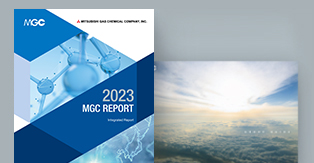MGC’s Vision of
Carbon-Neutral
World Circa 2050
MGC has set a long-term target of achieving carbon neutrality, defined as net zero greenhouse gas emissions, by 2050. Society is counting on chemical manufacturers to accelerate decarbonization through the power of chemistry. MGC is embracing this challenge as an opportunity to further develop and apply its distinctive technologies. MGC aims to create societally beneficial value in the form of climate change mitigation on a global scale. More specifically, MGC plans to help build clean energy systems and carbon cycle technologies that effectively utilize CO2 as a chemical feedstock.
Contributing to Carbon-Neutral
Energy Systems and CO2 Utilization
MGC has been amassing and refining technologies for production, handling and utilization of methanol and ammonia since its inception. This intellectual property and know-how has promising prospects of being adapted and applied to capturing and recycling CO2 and building hydrogen supply chains. Additionally, natural gas exploration and development technologies with which we have a long track record are now being applied to geothermal power, a renewable energy source garnering growing attention.
In sum, MGC possesses proprietary technologies, experience and specialized human resources that will be instrumental to achieving carbon neutrality. The following are decarbonizing energy systems/solutions we believe we can refine to a level where they can be deployed in society.
-
1Methanol energy
Methanol, a chemical with a broad range of applications, is a stable liquid at normal ambient temperature/pressure, making it easy to handle. It is expected to be widely used as a hydrogen carrier in addition to as a combustible fuel and in methanol fuel cells. MGC has developed a circular carbon methanol (CCM) production process that does not add CO2 to the atmosphere. In summer 2021, MGC succeeded in using CO2 as a feedstock to produce methanol that meets international product standards. MGC is developing and applying next-generation methanol technologies.
-
2Ammonia energy
Ammonia is made from hydrogen and atmospheric nitrogen. As both a fuel and a hydrogen carrier, ammonia is an ideal CO2-free energy substance. Carbon-neutral ammonia is obtainable by using the CO2 generated by ammonia production as a feedstock for blue hydrogen or green hydrogen, the latter of which is made using renewable energy whereas production of the former involves CO2 capture and storage. MGC aims to soon make carbon-neutral ammonia a reality as next-generation clean energy.
-
3CCUS
CCUS (CO2 capture, utilization and storage) includes CCS and CCU technologies, both of which capture CO2 that otherwise would be emitted into the atmosphere. The difference between the two is that the captured carbon is stored in the ground with CCS and utilized as a resource with CCU. In addition to researching conversion of CO2 into a resource, MGC has also been involved in proof-of-concept testing of CCS in Japan since 2012. MGC is working on deploying CCU and CCS in blue hydrogen production and carbon-neutral power generation.
-
4Direct air capture(DAC)
DAC is a technology that captures CO2 directly from the atmosphere using specialty chemicals that adsorb or absorb atmospheric CO2, which is then collected by, e.g., heating or depressurizing the chemicals. DAC is expected to be used as a carbon recycling technology that directly captures atmospheric CO2 for conversion into a resource. MGC aims to contribute to highly effective DAC technology through basic research on specialty amines that adsorb CO2.
-
5Hydrogen energy
(methanol/ammonia)Hydrogen is increasingly drawing interest as an energy source that does not emit CO2 even when combusted. Methanol and ammonia, both partly made up of hydrogen, are well-suited as hydrogen storage/transport media given the ease with which hydrogen can be extracted from them through chemical reactions. Leveraging its strengths, MGC is developing technologies to utilize hydrogen as a next-generation energy source. One such technology already on the market is the MH-MD process, which employs a proprietary catalytic technology to produce hydrogen from methanol.
-
6LNG-fired power generation
+ CCUSNatural gas, the least carbon-intensive fossil fuel is prominently positioned as a transitional energy source on the path to carbon neutrality. Capitalizing on its long experience in natural gas exploration and development, MGC is involved in LNG-fired power generation projects and aims to contribute to energy systems that will help achieve carbon neutrality by combining CCS and CCU technologies that capture CO2 emitted by, e.g., power plants and respectively store it in the ground or convert it into a resource.
-
7Geothermal power generation
Situated in the Circum-Pacific Volcanic Belt, Japan is ranked third in the world in terms of geothermal resources. Geothermal power generation is fueled by thermal (magma) energy deep beneath the earth’s surface. As such, it emits hardly any CO2, making it an exceptionally eco-friendly energy source. The MGC Group is the only chemical manufacturer in the geothermal power business, where it enjoys a technological advantage by virtue of its natural gas exploration and development technologies. While currently building its third geothermal power plant in Japan, the Group is conducting research to identify additional geothermal sites elsewhere.
-
8Carbon-neutral MGC plants
In the carbon-neutral world envisioned by MGC, its plants will utilize carbon-neutral energy sources such as geothermal and hydrogen (methanol/ammonia) fired power plants. If CO2 in the atmosphere can be utilized as a resource in the production of various chemical products like methanol and plastics through CCS and/or DAC, MGC would be able to realize ideal carbon-neutral production plants.

Developing new chemical processes with CO2 as a feedstock
Ryotaro Umezu
Tokyo Research Laboratory, MGC
I am working on developing new polycarbonate production processes that use CO2 as a feedstock. My job involves a wide range of development tasks, from research using flasks to planning of production plants. We are collaborating on this development program with industry and academic partners. We spend our days doing analysis, testing and experiments while receiving a lot of intellectual stimulation from both within and outside the MGC Group. Technologies currently under development mainly aim to not only convert CO2 into a solid but also reduce CO2 emissions throughout the entire polycarbonate production process. As a leading polycarbonate maker, we feel that reducing production processes’ CO2 emissions is a societally meaningful task that can help prevent global warming. Additionally, we expect the technologies we develop here to have other applications, including chemical synthesis and improvement in energy efficiency.
Development of Products
Conducive to Decarbonization
The MGC Group is currently accelerating development of products conducive to improved energy efficiency and decarbonization of society as a whole in accord with its mission of creating value to share with society. Core MGC technologies are integral to such products’ development. For example, one such technology has the potential to upgrade the performance of power semiconductors that govern control and conversion of electricity. In the mobility sector, MGC has technologies that can reduce vehicles’ weight and increase their operating efficiency. In the electricity storage space, MGC technologies could improve the performance of next-generation battery materials. In 2021, MGC unveiled a circular carbon methanol production process that recycles CO2, waste plastics and other substances by converting them into methanol for use as a chemical feedstock, fuel or power source as one means of decarbonization.
-
1Solid-state batteries (for EVs)
Rapidly rechargeable solid-state batteries with form-factor flexibility are seen as a key accelerant of EVs’ proliferation. MGC is developing highly safe solid electrolytes for solid-state batteries in collaboration with academic researchers. Its solid electrolytes are flexible and adhere easily to batteries’ electrode layers.
-
2Fuel cells (for FCVs)
FCVs run on energy generated by onboard fuel cells. MGC already offers direct methanol fuel cells. In addition to direct use of methanol, MGC also has hydrogen utilization technologies that are expected to play a key role in the FCV market.
-
3Vehicular weight reduction
While EVs are expected to continue to grow in prevalence, increases in their onboard batteries’ weight are a potential headwind. One of the MGC Group’s strengths is engineering plastics that help to realize lighter-weight vehicle bodies. MGC is also developing production technologies that utilize captured CO2 as a feedstock for, e.g., polycarbonate resins.
-
4Improvement in vehicle
operating efficiencyMGC manufactures an optical resin polymer used in smartphone camera lenses. In response to its superior optical properties, the market for the polymer is expanding to other applications, including automotive sensing cameras that support autonomous driving. Optimized autonomous driving is expected to contribute to decarbonization by improving energy efficiency.
-
5Energy control systems
Power semiconductors that increase energy control systems’ efficiency play an essential role in both people’s everyday lives and reduction of environmental burden. MGC is contributing to decarbonization of society by developing and commercializing, e.g., products that facilitate production of high-efficiency semiconductors and new materials for printed circuit boards.

Growing geothermal power into the leading natural energy source
Shohei Takano
Operation and Maintenance Group,
Yuzawa Geothermal
Power Corporation
Although Japan possesses few natural resources, it has the potential to be a world leader in geothermal energy. In 2019, we commissioned into operation the Wasabizawa Geothermal Power Plant, Japan’s first new large-scale geothermal power plant in 23 years. I am involved in the plant’s operations in addition to geothermal development. Geothermal power plants stably generate electricity 24 hours a day, 365 days a year by harvesting and utilizing steam from water boiled by magma deep underground. Geothermal power is clean energy well-suited to the coming carbon-neutral era. We are currently engaged in geothermal power generation or development at three sites in Japan. We will continue to grow our geothermal business to better contribute to increasing clean energy’s share of Japan’s electric power mix, improving power generation efficiency and mitigating climate change.








